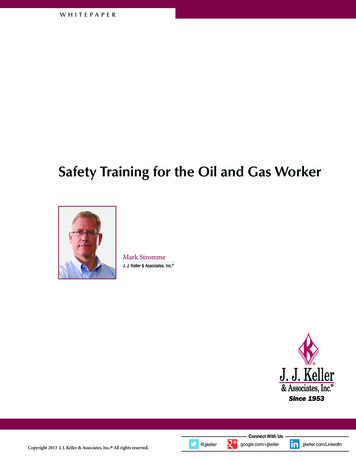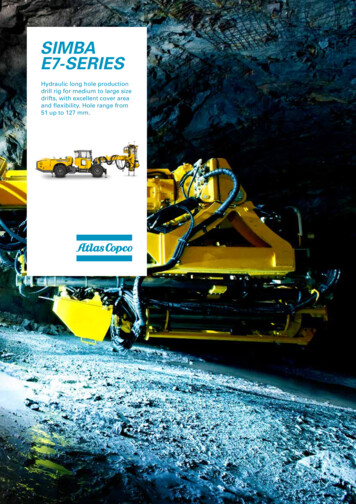
Transcription
W HI T E PA P E RSafety Training for the Oil and Gas WorkerMark StrommeJ. J. Keller & Associates, Inc. Copyright 2013 J. J. Keller & Associates, Inc. All rights reserved.
Safety Training for the Oil and Gas WorkerOver 450,000 workers were employed in the oil and gas extractionand support industries in 2011. These workers were engaged in manydifferent industrial processes needed to successfully drill and servicea well. These processes frequently require the use of specializedequipment and specialized work crews.According to the Census of Fatal Occupational Injuries from 2003to 2010, 823 oil and gas extraction workers were killed on the job—afatality rate seven times greater than the rate for all U.S. industries. Thisdatabase also reports similar fatality rates since at least the early 1990s.In addition, the Bureau of Labor Statistics reported in August 2013 thatthe oil and gas industry has had a 23 percent increase over last year inits fatality rate. To combat the increase in fatalities, OSHA has indicatedthat there will be a “national stand down for safety” for the oil and gasindustry in November 2013.To combat theincrease in fatalities,OSHA has indicatedthat there will be a“national stand downfor safety” for the oiland gas industry onNovember 14, 2013.Currently, for regions located in areas of significant oil and gas drilling,OSHA uses national, regional, and local emphasis programs to inspectoilfield worksites. Five OSHA regions had emphasis programs at thetime this was written. They were all set to expire on September 30, 2013.Oftentimes these are replaced with new programs to avoid gaps inOSHA’s scrutiny of the oil and gas industry.Understand the OSHA regulationsMany hazards found on oil and gas well drilling and servicing rigsare common to virtually all workplaces. These hazards are typicallyaddressed by OSHA’s General Industry Standards (29 CFR Part 1910) andthe Construction Standards (29 CFR 1926). When a serious hazard existsin the workplace that is not addressed by a specific standard, OSHA mayapply Section 5(a)(1) (“General Duty Clause”) of the OSH Act.Recognizing hazards is the first step in protecting employees on oil andgas drilling and servicing sites.Identify hazardsSafety and health hazards and dangerous conditions that can result infatalities for oil and gas workers include: Vehicle accidents Struck-by/caught-in/caught-between Explosions and fires Falls Confined spaces Chemical exposuresTraining for oil and gas workers on drilling and servicing sites oftenfalls into the same category as for general industry and constructionworkers. Hazards common to many industries, including oil and gas, arefalls from elevated platforms, slipping/tripping hazards, and machineguarding hazards.Copyright 2013 J. J. Keller & Associates, Inc. All rights reserved.Safety Training for the Oil and Gas Worker2
However, the unique hazards and special work circumstances on oiland gas sites often require specific hazard training. Unique hazardsinclude those related to the cathead and rotary table (caught-in andstruck-by hazards) and well pressures (explosions, fire, and struck-byhazards).Protect employeesOSHA requires employers to provide employees with a safe workenvironment. To do that properly, an assessment of the worksite forhazards must be made. That is where the identification of any uniquehazards will be uncovered.Once hazards are identified, employers have to provide a way tocontrol or mitigate them.Control exposuresControlling exposures to workplace hazards is the fundamentalmethod of protecting workers. A “hierarchy of controls” should beused as a means of determining how to implement effective controls.The National Institute for Occupational Safety and Health recommendsthe following order of preferred control:1. Elimination — Eliminating the source of the hazard (e.g., using adry scrubbing pad rather than a dangerous chemical).2. S ubstitution — Using a less hazardous chemical or piece ofequipment.3. E ngineering controls — Removing a hazard or placing a barrierbetween the worker and the hazard (e.g., ventilation, guarding).4. A dministrative controls — Using procedures and methods thatsignificantly reduce exposure to hazards by altering the way inwhich work is performed (e.g., job rotation, alternative tasks,redesign of work methods, and rest breaks).Some of the OSHAstandards that requiretraining include fallprotection, confinedspaces, hazardcommunication, andoperating materialhandling equipment.5. P ersonal protective equipment — Providing devices that are wornor used while working to protect the employee from exposureto workplace hazards. PPE includes respirators, safety glasses orgoggles, hearing protectors, gloves, steel-toe safety shoes, etc.Provide trainingTraining plays an important role in protecting workers from theidentified hazards. Effective safety and health training is needed tomake sure employees (including contract workers) understand thehazards to which they may be exposed and how to prevent harm tothemselves and others.Employers are required to provide workers with training that addressesthe hazards particular to their worksites. These training programs mustprovide employees with complete information on: Processes they are involved in, Equipment they might need to use, PPE and other protection available, and Potential effects of exposure to chemicals.Copyright 2013 J. J. Keller & Associates, Inc. All rights reserved.Safety Training for the Oil and Gas Worker3
Training timetableEmployee safety training must be done on specific safe work practicesbefore an employee begins work. Additional training is needed for newwork processes and when accidents and near misses occur. Refreshertraining is also necessary for some topics on a routine basis. Someof the OSHA standards that require training include fall protection,confined spaces, hazard communication, and operating materialhandling equipment.Types of trainingTraining can take many forms: formal classroom training, daily safetyhuddles, and online training. In addition, safety programs must includeon-the-job mentoring and task- and site-specific training.Initial classroom training is an effective way to teach rig hands propersafety procedures before they step onto a rig site. The training canconsist of lecture, video training, and simulated hands-on training. Thistype of training is also a good way to provide needed refresher trainingfor experienced workers.Daily safety meetings (often referred to as “safety huddles” or “safetyscrums”) take place at the rig site, usually before an employee’s shift ortour begins. They are typically short, informal meetings and can takeplace in the doghouse, tool-pusher’s trailer, or even on the derrickplatform. The meetings are a quick and effective way to instruct handsin the hazards they may be exposed to on their tour and provideguidance on protection and alerting procedures if there is a problem.The key is to “watch and be aware” of the hazards.Online training is a convenient, self-paced way for workers to get thenecessary training anytime, anywhere there is an internet connection.Rig hands can log on, relax, and learn at the speed they are comfortablewith.When new work and safety procedures and processes are instituted,employees need to be made aware of them and understand what theyare required to do. That is where additional training comes into play;getting rig hands “up to speed” on how to protect themselves from anynew potential hazards.Accidents and near misses are often a sign that training is lacking.Reporting of all accidents and near misses should be encouraged, inorder to take advantage of the freshness of the incident. Taking a safetystand down is a great idea when these occur. All hands can benefit fromadditional training. Often during the training, the cause of the accidentsand near misses are discovered and solutions can be developed byemployees and management to help prevent more incidents. Hands can“discover and uncover” the causes of the incidents.Refresher training is an important way to reinforce safety practices thatmay have been taught months or even years ago. This training keepshands “grounded and aware” of hazards they may have forgotten.Copyright 2013 J. J. Keller & Associates, Inc. All rights reserved.Safety Training for the Oil and Gas Worker4
Employees new to theoil and gas industryare especiallyvulnerable to beinginjured or killed intheir first months onthe job.Rookie workersEmployees new to the oil and gas industry are especially vulnerable tobeing injured or killed in their first months on the job. These new righands typically have a greater risk of injury, not only to themselves, butto the experienced employees around them, as well. That is becausethese new hands have not worked with an established rig crew and maynot be aware of important safety and work procedures. Because of this,rookie workers often need a higher level of training.Experienced workers are often assigned “to keep an eye on” rookieemployees during their first few months on the job. That is where theon-the-job mentoring and task- and site-specific training come intoplay.ConclusionWith the oil and gas industry growing each year, the need for workers inthis field is also rising. As new workers are hired, necessary preparationand training needs to be provided so that these workers are educatedon the safe work practices associated with drilling and servicing awell. At the same time, experienced oil and gas workers should not beoverlooked. They may need retraining to combat potential complacencyor bad habits, as well as new safety and health hazards that may exist inthis fast changing industry. Having knowledgeable and fully qualifiedemployees on the worksite, whether experienced or new, creates a saferenvironment for all, and could ultimately save lives.Copyright 2013 J. J. Keller & Associates, Inc. All rights reserved.Safety Training for the Oil and Gas Worker5
About the AuthorMark StrommeJ. J. Keller & Associates, Inc. Mark Stromme is one of the lead safety editors at J. J. Keller & Associates, Inc. He specializes in OSHA construction andgeneral industry safety and is an authorized OSHA Construction Outreach Trainer. At J. J. Keller Mark researches anddevelops content for a variety of proprietary products, including training videos, newsletters, handbooks, manuals, andsoftware. His work has also appeared in ISHN, Occupational Health & Safety, Workplace HR & Safety, BIC, EHS Today,Modern Contractor Solutions, and Tow Professional. Mark contributed to the OSHA 5810 – Hazards Recognition andStandards Training for the Oil and Gas industry and speaks frequently to industry groups about safety and regulatory issues.About J. J. Keller & Associates, Inc. Since its beginning as a one-man consulting firm in 1953, J. J. Keller & Associates, Inc. has grown to become the mostrespected name in safety and regulatory compliance. Now over 1,200 associates strong, J. J. Keller serves over 350,000customers — including 90% of the Fortune 1000. The company’s subject matter expertise spans nearly 1,500 topics and itsdiverse solutions include mobile technology, interactive and online training, online management tools, managed services,advisory services, publications, forms and supplies.J. J. Keller helps safety professionals build a better safety program through its in-house expertise and wide selection ofworkplace safety products and services, from facility marking signs and PPE to compliance manuals and on-demandtraining. For more information, visit jjkeller.com.How We Can HelpJ. J. Keller’s Oil & Gas Safety Compliance Manual is designed specifically for safety managers, operations managers,safety trainers and contractors working in oil and gas fields. It includes need-to-know requirements and best practices forcritical OSHA, DOT and EPA oil and gas topics: goals and objectives of an oil and gas safety programhealth and safety hazards in oil fieldspersonal protective equipment and how to inspect, test and maintain itdetermining if an injury or accident is recordablehow to create, refine and evaluate a safety compliance programTo learn more about this manual—or view our complete line of safety and compliance products for the oil and gasindustry—visit jjkeller.com. Or you can contact us at 800-327-6868.Laws, regulations, and best practices change. The observations and comments drawn today may not apply to laws, regulations, orbest practices as they may be in the future. J. J. Keller & Associates, Inc. cannot and does not assume responsibility for omissions,errors, or ambiguity contained in this whitepaper. Individuals needing legal or other professional advice should seek the assistanceof a licensed professional in that field.Copyright 2013 J. J. Keller & Associates, Inc. All rights reserved.35669Safety Training for the Oil and Gas Worker6
J. J. Keller's Oil & Gas Safety Compliance Manual is designed specifically for safety managers, operations managers, safety trainers and contractors working in oil and gas fields. It includes need-to-know requirements and best practices for critical OSHA, DOT and EPA oil and gas topics: goals and objectives of an oil and gas safety program











